skip to main |
skip to sidebar
One of the joys of property owning is the recurrent need for repairs. This is particularly the case with a building dating from 1640 which is also Listed Grade II. From time to time, I review some of the work carried out.
I think the first post describing external repairs covered 2014 and is here.
2016
Prior to the Garden Party at Brewood Hall in 2016 (described in the post here) repairs were carried out on the garden paths at the front of Brewood Hall. Work started with the delivery of materials by a large lorry equipped with a remotely-controlled self loading/unloading hydraulic crane.

Path repairs at Brewood Hall: OCL lorry (with a remotely-controlled self-loading/unloading hydraulic crane) delivering materials.
A couple of days later, a large skip was delivered to carry away spoil from the repairs.

Path repairs at Brewood Hall: Delivery of a large skip to carry away spoil.
The paths at the front of the building were relaid by Jim and Pete from A. M. Griffiths, together with Dave who has looked after the gardens (extending to about one acre) for some years.
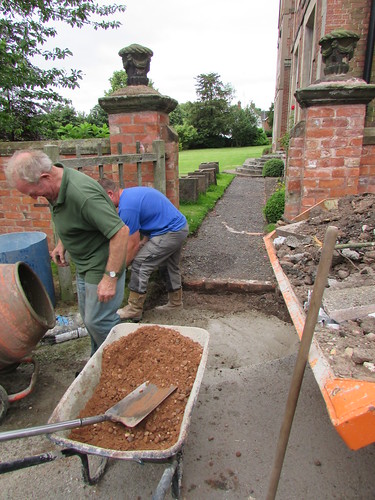
Path repairs at Brewood Hall in 2016.
2017
During 2017, improvements were carried out to the path at the rear of the building where damaged stone slabs were replaced by reclaimed paviours to better match the paved area outside the kitchen and the small barn. Further work will eventually improve the adjacent decorative cobbled area.
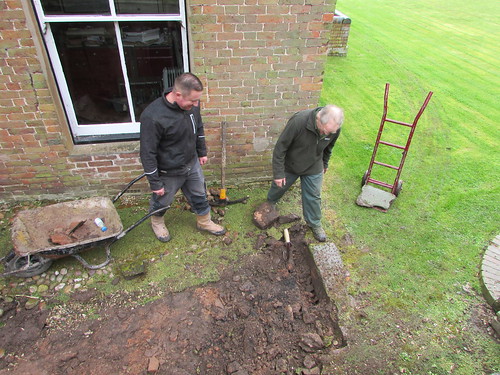
Brewood Hall: Jim and Dave working on repairs to path at rear.
To gain access to the front elevation allowing repairs to the decorative cement quoins, a 'Genie' Self-Propelled Articulating Boom Z-45/25 was hired in. Whilst the machine was on site, some high-level repointing of brickwork was also carried out. It was an amazing machine and I took some pictures from an elevated position. The work was completed prior to the Brewood Garden Party in 2017 (described in the post here).

Repairs at Brewood Hall: 'Genie' Self-Propelled Articulating Boom Z-45/25
In November 2017 I visited Cawarden Brick and Tile Reclamation Yard near Rugeley with Brendan where we obtained sufficient reclaimed Staffordshire Blue Edgers for the front path which Dave later installed.

Cawarden Brick and Tile Reclamation Yard: Brendan inspecting reclaimed edgers.

Brewood Hall Garden 2018: Reclaimed edging installed adjacent to the front path.
Related posts on this website
Brewood Hall Maintenance.
Brewood Hall Tree Maintenance.
To see all my posts on Brewood Hall, select Label 'Brewood Hall' or click here.
My Pictures
Where necessary, clicking on an image above will display an 'uncropped' view or, alternately, pictures from may be selected, viewed or downloaded, in various sizes, from the album below:-
Repairs at Brewood Hall.
Reclamation Yard.
Brewood Hall garden has a number of trees. Just as the Hall itself, a Listed Building, requires maintenance the trees also require periodic inspection and attention. The situation is complicated because all the trees are within the Brewood Conservation Area.
In 2012 a group of oak trees along one boundary were pruned for the second time and this is described in the post here.

Oak Tree Pruning at Brewood
In September 2014, a self-set sycamore very near the front garden wall had to be felled. It had grown so as to threaten to demolish the garden wall. Although I'm not keen on sycamore, I'd given it a chance to grow clear of the wall but, of course. it didn't oblige. With a chain saw and an expert bit of rope work, Rik and Dave safely brought down the main trunk across the front lawn before quickly reducing the tree to a series of 'rounds'.

Sycamore felling at Brewood Hall, with Dave on the rope.
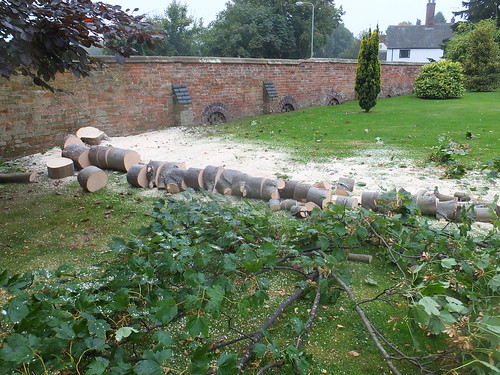
Sycamore felling at Brewood Hall: The felled tree reduced to a series of 'rounds'.
In contrast, I find silver birch attractive. My partner had planted one near the front gates in the 1980s as a replacement for a much older silver birch nearby which had been well-established when I came to Brewood in 1971 but had since died. The replacement tree lasted until 2017 when inspection showed that it was in danger of collapse so, reluctantly, I agreed to felling and Rik and Dave promptly carried out the work on 25th October 2017.

Tree felling at Brewood Hall: This view shows the height of the felled tree.
Related posts on this website
Oak Tree Pruning at Brewood Hall
My Pictures
Where necessary, clicking on an image above will display an 'uncropped' view or, alternately, pictures from may be selected, viewed or downloaded, in various sizes, from the album below:-
Oak Tree Pruning at Brewood.
Brewood Hall: Sycamore felling.
Felling of dying silver birch.
Even casual perusal of this blog is likely to reveal my enthusiasm for driving steam locomotives, latterly at a couple of preserved railways in the United Kingdom. At the Battlefield Line, I also drive the Diesel Multiple Units (DMU) owned by Ritchie Marcus and there's a steadily-increasing number of posts describing this (you can find them all here or by selecting 'DMU' from the list in 'Labels to select a blog topic').

DMU Days at the Battlefield Line: After taking the school party to Shenton on 4th July 2017, the 1-car coupled to the 2-car set wait at Shenton prior to the return to Shackerstone.
In the summer of 2018, these diesel railcars provide the 'Midweek Services' on Tuesdays, Wednesdays and Thursdays so I seem to be getting regular DMU driving turns. I've always enjoyed driving the 'British Railways Modernisation' DMUs, which I remember from my own childhood when they were first introduced but the afflictions of increasing age make a 'diesel day' increasingly attractive for a number of reasons.
Firstly, preparation time is much reduced, compared with steam. 'Checking levels', as on a car, is required but the laborious 'oiling round' is avoided. Whilst a visual examination around the underframe is essential, once the engines are started, also from ground level, the driver can return to the cab whilst the compressors establish sufficient control air pressure to allow movement.
Secondly, driving is carried out whilst seated. Whilst I don't find the seat design particularly good (and manoeuvring around it is tight), it represents luxury compared with most steam locomotives which either make no provision for sitting or offer a rather mean wooden tip-up seat. Gresley is renowned for fitting a padded leather bucket seat on some of his steam locomotives. On most designs, many drivers (the writer included) preferred to remain standing to make the most of the poor forward vision offered by the cab design.

Detail of the driver's adjustable seat.
I often say '90% of a driver's attention should be focussed on the line ahead'. We can debate the exact percentage but keeping a good lookout is vitally important. The windows across the full width of the DMU cab give a panoramic view down the line very welcome to steam drivers brought up on leaning out of the cab to get reasonable sightlines around the front of the boiler. Provided the blinds at the rear of the DMU cab are raised, the passengers, too, can enjoy the view of the route ahead. The blinds were provided, of course, for use at night when the lights in the passenger compartment would otherwise damage the driver's night vision. More modern designs of diesel railcar reverted to solid walls between passengers and cab.

DMU Days at the Battlefield Line: Driver's view leaving Market Bosworth for Shackerstone.
On a steam-hauled train, to give the driver any chance of watching the line ahead, it's a requirement that the locomotive is a the front of the train (except where special arrangements are made called 'push-pull' or 'auto' trains). This means that, at each and of the line, there's a period of furious activity where the locomotive is uncoupled from the coaches, shunted to the other end of the train and re-coupled. On DMU, a driving cab is provided at each end of the train so that, at the end of the line, it's only necessary for the driver to 'close' what had been the leading cab, move to the other end of the train and 'open' what had been the 'back cab' so as to become the leading cab. The business of 'closing' and 'opening' cabs involves the transfer of an electrical master key and removable handles to control the final drive and braking systems.
Although the supply of coal carried by a steam locomotive is normally arranged to suffice for a whole day, the water supply (which is boiled to produce steam, used to impel a piston up and down a cylinder producing useful work and then discharged as exhaust steam from the chimney) often requires replenishment a number of times a day. By contrast, a DMU may be able to run for a number of days before the diesel fuel tanks require topping-up and water (used to cool the diesel engines, as in a car) is recirculated.
 Refuelling the DMU at Shackerstone.
Refuelling the DMU at Shackerstone.
On a DMU, the driving controls, instruments and indications are laid out on the desk in front of the driver in a reasonably ergonomic manner unheard of on steam locomotives although Riddles, in designing the British Railways 'Standard' steam locomotives, attempted a convenient layout.

The driving controls, instruments and indications are neatly laid out on the desk in front of the driver.
Drivers also appreciated the 'power on demand' nature of the DMU. With steam traction, the power available to work the train depended upon many factors including time since last 'shopping', time since last boiler washout, quality of coal and, not least, attitude and competence of the fireman. In contrast, a DMU normally works as intended or doesn't work at all. That's a bit of a simplification but, in general, when a diesel driver opens the throttle, the power will flow, giving the driver a feeling of confidence that the job will go well.
But perhaps the best feature of working on a DMU is the opportunity to meet passengers. Many passengers seek out a seat in the leading coach where they can see the line ahead and watch the driver at work. In stations, passengers (men, ladies and children) can often be seen studying the cab and may ask questions. When working on steam, although we always try to acknowledge anyone nearby, the workload involved hinted at above means that a protracted chat is rarely possible. In contrast, when working on a DMU there are better opportunities for passengers to take photographs of the driver's 'office' or to answer questions (admittedly at the risk of boring them to tears - 'too much information'). I never cease to be amazed at the interesting backgrounds and experiences of our visitors. And, at the end of the day, I'm not quite as shattered (or dirty) as after a steam 'turn'.
On Saturday, 7th July 2018, the Brewood Garden Party was held, for the sixth time, in the garden at Brewood Hall. The event is organised by 2nd Brewood Scouts, Brewood Parish Church and the informal group Friends of Brewood Hall. All of the work organising and running the event is carried out by volunteers.
Preparations
As in previous years, there was an organising committee who met a number of times in the months prior to the event to ensure that visitors enjoyed their visit on the day. 'Flyers' had been distributed around the village, posters and a banner had been put up and there were announcements on social media. Erection of the tents and stalls was started on the evening of Friday, 6th July, using a different layout to previous years which proved popular.
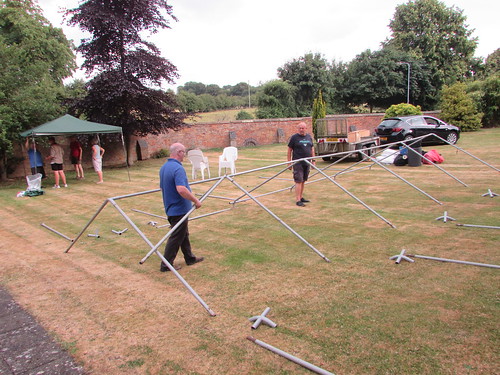
Brewood Garden Party 2018: Setting-up on Friday: Methodical erection of the craft marquee.

Brewood Garden Party 2018: Setting-up on Friday: Welcome reinforcements!
 Brewood Garden Party 2018: Setting-up on Friday. L-R: Band tent, Pimm's Tent, Tombola tent, Craft Tent.
Brewood Garden Party 2018: Setting-up on Friday. L-R: Band tent, Pimm's Tent, Tombola tent, Craft Tent.
Setting-up was completed on Saturday morning, following an early start, so as to be ready for the opening at noon.
The Event
The whole week had been warm and Saturday was the same. All the usual stalls and diversions were provided, plus some innovations.

Brewood Garden Party 2018: Admission desk at front gates.
The Staffordshire Corps of Drums opened the proceedings with an impressive display. They admitted that, in the heat, the woollen uniforms were very uncomfortable.

Brewood Garden Party 2018: The Staffordshire Corps of Drums opened the proceedings.
The Refreshment Tent quickly became busy and remained busy. This year, the local Midland Counties Co-op store provided additional help which was very welcome.

Brewood Garden Party 2018: A wide range of snacks were available in the popular Refreshment Tent.
For the first time, local traditional butchers Maiden's offered hot dogs, burgers and frozen snacks.

Brewood Garden Party 2018: Maiden's ready for business.
The Pimm's Tent, Tombola and Plants and Produce stall remained popular.

Brewood Garden Party 2018: Plants and Produce Stall.
The Craft Tent featured the work of a number of local artists and crafters.

Brewood Garden Party 2018: Jan with local artist Rob.
Black Country Live Steamers appeared again with two immaculate miniature traction engines and, located in the driveway, were able to give rides.
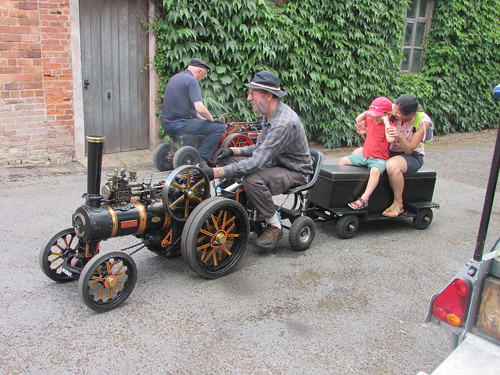
Brewood Garden Party 2018: Miniature traction engines from Black Country Live Steamers.
Chase Ferret Rescue were appearing for the first time. They had brought a number of ferrets and everybody was most impressed by the quality of the accommodation provided for the ferrets and the knowledge and care displayed by their volunteers.

Brewood Garden Party 2018: The Ferret Rescue stand.
I'd never handled ferrets before and I admit I was entranced by the creatures.

Brewood Garden Party 2018: Jan makes friends with a young ferret.
To appeal to our younger visitors, we had the Coconut Shy, Catapult Range and Wet Sponge Throwing together with the supervised Kids' Under-5 Zone.

Brewood Garden Party 2018: A busy time at the Kids' Under-5 Zone.
A new attraction in 2018 for children was the Toys and Sweets stall.

Brewood Garden Party 2018: View of Toys and Sweets Stall which also provided welcome shade to some visitors.
Later in the afternoon, there were Egg and Spoon and Sack Races.

Brewood Garden Party 2018: Childrens' Sack Race.
Everyone was delighted that, once again, the Cannock Bands, based at the Cannock Performing Arts Centre, returned to play for us.
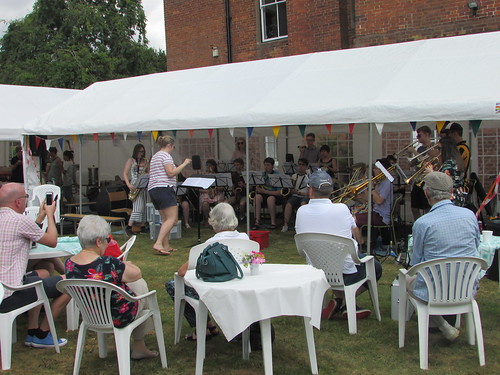
Brewood Garden Party 2018: Cannock Wind Band performing. Because of the heat, they were not in their customary black uniforms.

Brewood Garden Party 2018: Cannock Big Band performing: The view looking towards the audience.
Finally, the Staffordshire Corps of Drums gave a second display.

Brewood Garden Party 2018: A second performance by the Staffordshire Corps of Drums.
In choosing the date for this year's garden party, the organising committee were faced with the difficult problem of trying to avoid competing attractions. What they could not have known was that the English football team would achieve a measure of success in the World Cup being played in Russia, resulting in the team having a match starting at 3.00 p.m. on the day of the garden party. A mass early exodus was anticipated with people seeking to watch the match on television. The timing of the band performances at the garden party was brought forward to help and the Scouts brought their 50-inch plasma television. This was set up in the band tent (after the band performances) and hooked-up to the Brewood Hall aerial system, allowing people to remain on site and watch the game!
England lost in their World Cup match but lots of people confirmed that the Brewood garden party had been a splendid event.
Reports on earlier garden parties at Brewood Hall
Brewood Vintage Garden Party 2013.
Brewood Vintage Garden Party 2014.
Brewood Garden Party 2015.
Brewood Garden Party 2016.
Brewood Garden Party 2017.
Pictures of the event
Where necessary, clicking on an image above will display an 'uncropped' view or, alternately, pictures from may be selected, viewed or downloaded, in various sizes, from the album below:-
Brewood Garden Party 2018.
In 2018, the Battlefield Line was closed until Easter to allow track relaying to be carried out.

Battlefield Line, early 2018: Relaying south of Headley's Crossing.
Whilst the railway was closed, in connection with testing work for an outside client, I did drive the single unit diesel railcar on a few days. This was confined to running between Shackerstone and Headley's Crossing.
My first passenger turn at the Battlefield line in 2018 was on Wednesday, 4th April, just after Easter, when the 2-car Diesel Multiple Unit was rostered. That day didn't go quite to plan and I ended up operating with the single unit diesel, as described here.
Then, I was overseas for a few weeks in Myanmar (Burma), as described in a series of posts starting at Travelling again.
So my first steam 'turn' at the Battlefield Line in 2018 wasn't until the Fish and Chip Evening Special on 9th June 2018. The popular 'Fish and Chip' trains operate on a number of dates during the year and I described an earlier 'Fish and Chip Special' (using 'Cumbria') here.
Events of 9th June 2018
Carl was rostered as driver for the five service trains during the day but he asked if I'd care to take the last round trip as he was Signalman for the evening 'Fish and Chip' train. So I was waiting on platform 2 at Shackerstone when the 'Light Prairie', 5542, arrived after the fourth round trip.

Battlefield Line, 9th June 2018: 5542 drifts into Shackerstone on the 4th service train of the day.
Carl turned the engine over to me, Tracy uncoupled and we ran around the train, pausing for water before coupling onto the train ready for the 4.15 p.m. departure to Shenton.

Battlefield Line, 9th June 2018: Carl dismounts from 5542 on arrival back at Shackerstone with the 4th service train of the day.
We operated the last round trip to Shenton and on arrival back at Shackerstone were routed into platform 1 where the main station facilities (tea room, museum and toilets) are located. There was then plenty of time to uncouple and run round, stopping to fill the side tanks at the water column on platform 2. Now hooked onto the south end of our four coach train, the engine simmered as we waited for our 80 guests to arrive.

Battlefield Line Fish and Chip Evening Dining train, 9th June 2018: Waiting for our guests to arrive.
Slowly, the train filled with our diners and at 7.00 p.m. we received the 'Right Away' from the Guard. I gently started the train away, complied with the 5 m.p.h. speed restriction on the crossover leading to the single line and collected the Single Line Staff from the Signalman. There's a 10 m.p.h. speed restriction passing through the cutting to Barton Lane road bridge but once clear of the 'slack' I only let the speed rise a little - we were in no hurry on this trip as we trundled down the line and the tantalising smell of fish and chips wafted towards us from the train.
We were not booked to stop at Market Bosworth but we slowed right down when passing through the platform, allowing staff on the train to pass a portion of fish and chips to one of our Volunteers waiting on the platform. Once the delivery had been safely made, I let speed rise a little as we passed into the gently uphill cutting section spanned by three successive overbridges which took us towards Shenton. Once clear of the cutting, the line became gently downhill on Shenton Bank with views across the Leicestershire countryside on both sides of the train.
Near Shenton's fixed distant signal, I brought the train to a gentle stop so that our diners could admire the peaceful spot as they enjoyed their meal. Whilst at a stand, the locomotive crew were also issued with fish and chips - a welcome treat!.

Tracy enjoys her fish and chips.
After ten minutes or so, we received the about 'Right Away' from the Guard and trundled into Shenton station. There was then a few minutes of activity as we uncoupled, ran round and coupled back onto the train ready for the journey back to Shackerstone. It was a warm evening, still light and many passengers came onto the platform to take photographs or simply admire the locomotive. After a while, the train staff persuaded everybody back on board and the Guard gave the 'Right Away'. We were told to take it gently to Market Bosworth and then complete the journey at Line Speed, so we were able to have an enjoyable 'romp' to complete the trip. We were routed into platform 1 and, as our happy passengers made their way back to their cars, Tracy uncoupled to the final time. It didn't take us long to shunt onto the shed and complete disposal.
Related posts on this website
Battlefield Line Fish and Chip Evening Special (an earlier 'Fish and Chip' train).
To see all my posts about the Battlefield Line, select Label 'Battlefield Line' or click here.
My photograph albums
Where necessary, clicking on an image above will display an 'uncropped' view or, alternately, pictures may be selected, viewed or downloaded, in various sizes, from the albums listed:-
5542 GWR Locomotive
Battlefield Line, 2017-2018
All my Battlefield Line albums
Events of Saturday, 2nd June 2018
I travelled to Ely where Ann Matthews was "being presented" at the Open University Degree Ceremony in Ely Cathedral having graduated as Master of Arts in History. Five years previously, I'd made the same journey for her Bachelor of Arts Ceremony (that day is described here).
The Rail Journey
I took a taxi to Wolverhampton and train to Birmingham. From here, Cross Country still operate a service to Stansted Airport. A 2-coach 'Turbostar' DMU was deemed appropriate that day and we made a fairly leisurely progress through Nuneaton and Leicester onto the Peterborough line, still equipped with semaphore signals and manual signal boxes. At Oakham, we stopped but remained in the station. After a few minutes, the lady Train Manager (or whatever they are calling Train Guards at present) announced over the public address that we were awaiting Police to deal with a disruptive passenger. About twenty minutes later, a single police officer boarded the train. The passenger had clearly been disruptive very quietly as I was surprised to find that I was only a couple of seat rows away from him. Very politely, I heard the Officer explain that the passenger would not be allowed to travel further since the Train Manager claimed he had been rude. After further discussion, the passenger and police officer got off the train which then continued on its journey. Beyond Peterborough, we entered a former Great Eastern Railway line, which also retains semaphore signalling. Crossing this flat landscape through March towards Ely, there are numerous level crossings (mainly automatic half-barrier). We managed to lose a further ten minutes because of a signalling failure before joining the overhead electrified line from Kings Lynn at Ely North Junction, two miles north of Ely station where I left the train which continued through Cambridge to Stansted.

Ely Station, 2nd June 2018.
Railway Maps
'Railway Track Diagrams Book 4: Midlands & North West', Second Edition, published by Trackmaps (ISBN: 0-9549866-0-1).
'Railway Track Diagrams Book 2: Eastern', Third Edition, published by Trackmaps (ISBN: 0-9549866-2-8).
My railway pictures
West Midland Railways.
Nuneaton Station.
Leicester area rail.
Ely Station
The Ceremony
I walked as fast as I could from the station to Ely Cathedral to meet Ann, Dean and Dean's sister and we took our positions for the ceremony. The packed cathedral formed a suitably impressive venue. Ely Cathedral is famous for its architecture and for the remarkable octagonal tower above the nave crossing.

Ely: 2nd June 2018: The tower above the nave crossing.
A temporary stage had been built at the nave crossing for the Open University dignitaries.

Ely: 2nd June 2018.
With a few hundred presentations to be made, the business was carefully choreographed and proceeded briskly. Ann was presented fairly early in the morning's proceedings.

Ely: 2nd June 2018: Ann Matthews being presented.
At the completion of the presentations for the morning session, everybody trooped outside into the bright sunshine where something of a carnival atmosphere prevailed.

Ely: 2nd June 2018
We spent the afternoon enjoying the town and the market before having a celebratory meal at an Italian restaurant. Ann and Dean drove me to the station (they were staying overnight in Cambridge) and I had time to explore the station before catching a very crowded train back to Birmingham, then on to Wolverhampton and a taxi home.
My pictures of Ely and the ceremony
Ely 2018












































